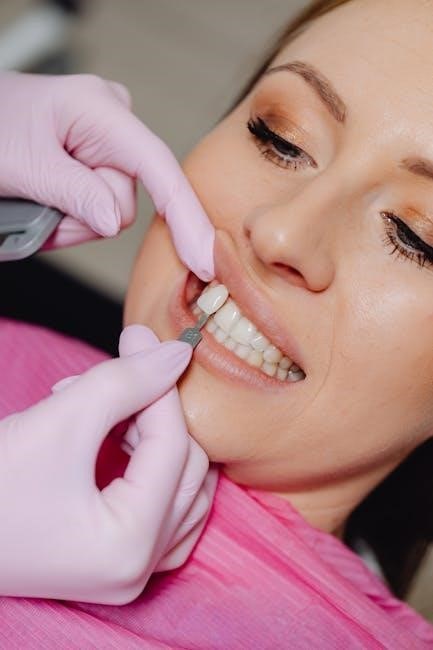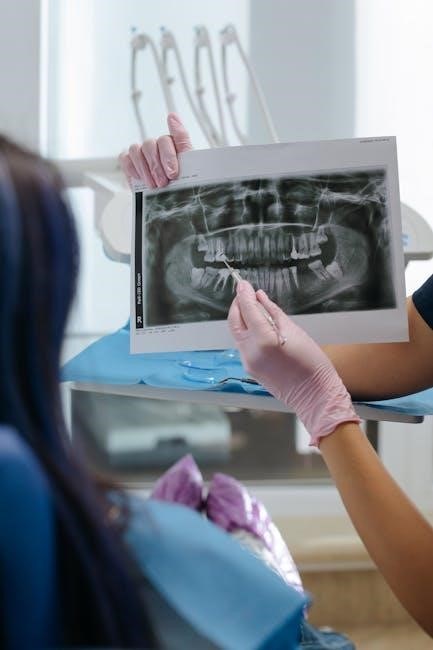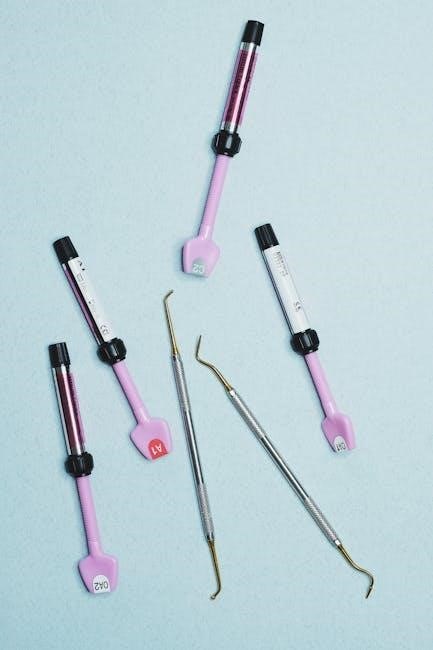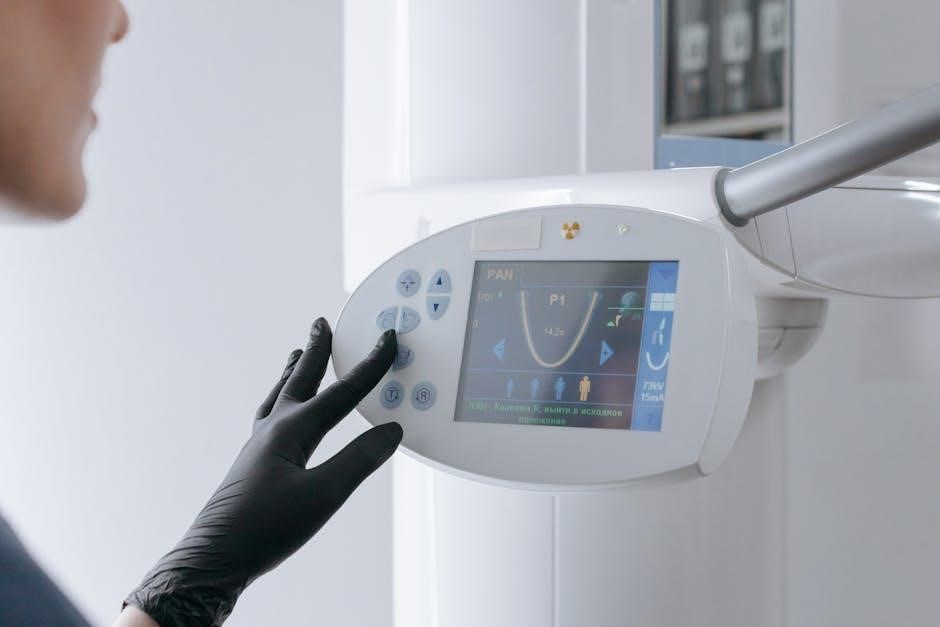Dental burs are essential tools in dentistry‚ used for precise cutting‚ shaping‚ and polishing of teeth. Available in various shapes‚ sizes‚ and materials‚ they cater to different procedures‚ from cavity preparation to crown adjustments‚ ensuring versatility in dental care.

Components of Dental Burs
Dental burs are precision instruments composed of three primary components: the shank‚ neck‚ and head. The shank is the part attached to the dental handpiece and is available in three types: friction grip‚ latch-type‚ and right angle. It ensures secure connection and proper rotation. The neck connects the shank to the head‚ providing structural integrity. The head is the working part of the bur‚ designed for cutting‚ grinding‚ or polishing. Its shape‚ size‚ and material vary depending on the intended use. Together‚ these components enable dental burs to perform precise operations‚ such as cavity preparation‚ crown adjustments‚ and bone surgery. Understanding the structure of dental burs is crucial for selecting the right tool for specific procedures‚ ensuring efficiency and accuracy in dental care.

Types of Dental Burs
Dental burs vary by shape‚ material‚ and size‚ catering to specific dental procedures. Common types include cylindrical‚ tapered‚ and inverted cone burs‚ each designed for unique applications like cutting‚ grinding‚ or polishing‚ ensuring versatility in dental care.
3.1. Classification by Shape
Dental burs are classified into various shapes‚ each designed for specific dental procedures. Common shapes include round‚ pear‚ cylindrical‚ inverted cone‚ tapered flat end‚ tapered round end‚ and flame-shaped burs. Round burs are ideal for initial cavity preparation and enamel cutting‚ while pear-shaped burs are used for precise cutting and shaping. Cylindrical burs are effective for flat surfaces and removing decay‚ and inverted cone burs are well-suited for creating undercuts. Tapered flat-end and round-end burs are used for refining and shaping tooth structures‚ while flame-shaped burs are designed for rapid material removal. Each shape is tailored to address specific clinical needs‚ ensuring efficiency and precision in dental procedures. This classification helps dentists select the most appropriate bur for their specific task‚ enhancing the accuracy and success of treatments.
3.2. Classification by Material
Dental burs are also classified based on the materials used in their construction‚ which significantly impacts their performance and longevity. The most common materials include diamond‚ tungsten carbide‚ and stainless steel. Diamond burs are highly durable and effective for cutting through hard tooth structures like enamel and dentin. They are often used for precise procedures such as cavity preparation and crown adjustments. Tungsten carbide burs are known for their hardness and are typically used for cutting softer materials‚ such as decayed dentin or bone. Stainless steel burs are more cost-effective and are often used for general-purpose cutting and shaping. Each material offers distinct advantages‚ making them suitable for specific dental applications. The choice of material depends on the procedure’s requirements‚ the type of tooth structure being worked on‚ and the desired outcome. This classification ensures that dentists can select the most appropriate bur for their clinical needs.
3.3. Classification by Size and Grit
Dental burs are also categorized based on their size and grit‚ which are critical factors in determining their application. The size of a bur refers to its diameter and length‚ with smaller burs used for intricate procedures like cavity preparation in tight spaces‚ while larger burs are employed for more extensive shaping or bone surgery. Grit‚ on the other hand‚ indicates the coarseness or fineness of the abrasive particles on the bur’s surface. Common grit sizes range from coarse (for rapid material removal) to fine (for polishing and finishing).
Coarse grit burs are typically used for initial cutting or removing large amounts of material‚ while medium grit burs are suitable for refining shapes. Fine grit burs are reserved for final polishing and smoothing surfaces. The combination of size and grit allows dentists to achieve precise control over the procedure‚ ensuring optimal results. This classification system helps in selecting the most suitable bur for specific clinical needs‚ balancing efficiency and precision in dental care.

Uses of Dental Burs in Various Dental Procedures

Dental burs are versatile tools in dentistry‚ essential for cavity preparation‚ crown adjustments‚ bone surgery‚ and polishing. Their precision enables effective shaping and refining in various procedures‚ from routine treatments to complex surgeries.
4.1. Cavity Preparation

Cavity preparation is one of the most common uses of dental burs‚ enabling dentists to remove decayed tooth material and shape the cavity for fillings. Various bur types‚ such as cylindrical‚ round‚ and inverted cone burs‚ are selected based on the size and location of the cavity. For instance‚ cylindrical burs are ideal for large cavities‚ while round burs are better suited for precise removal of decay in smaller areas. The choice of material‚ such as diamond or carbide burs‚ also plays a role‚ with diamond burs offering aggressive cutting for hard tissues and carbide burs providing durability for complex procedures. Proper use of dental burs ensures minimal tooth structure removal‚ preserving the tooth’s integrity. Additionally‚ burs are used to create undercuts and retentive areas‚ enhancing the retention of restorative materials like composite resins or amalgams. This step is critical for achieving a successful and long-lasting restoration‚ making dental burs indispensable in modern dental practice.

4.2. Crown Preparation
Crown preparation is a critical procedure in restorative dentistry‚ where dental burs play a pivotal role in shaping and refining tooth structures to accommodate dental crowns. Dentists utilize specific types of burs to remove enamel and dentin‚ creating the necessary space and morphology for the crown. Cylindrical and inverted cone burs are commonly employed for bulk reduction‚ while tapered and flame-shaped burs are used for fine contouring and creating marginal bevels. Diamond burs are preferred for their aggressive cutting efficiency‚ especially in hard tooth structures‚ while carbide burs offer durability and precision for detailed shaping. Proper use of these instruments ensures minimal tooth reduction‚ preserving the tooth’s structural integrity. Additionally‚ burs are used to create chamfers or shoulder preparations‚ depending on the type of crown being placed. The precision and control offered by dental burs make them indispensable in achieving optimal crown fit and aesthetics‚ ensuring successful long-term outcomes for patients. Their versatility in crown preparation underscores their importance in modern dental restorative procedures.
4.3. Bone Surgery
Dental burs are indispensable in bone surgery‚ particularly in orthodontic and implant procedures‚ where precise shaping and removal of bone tissue are required. Large‚ round‚ or cylindrical burs are often used to remove bone material efficiently‚ while inverted cone or flame-shaped burs are preferred for finer contouring and creating defined edges. These instruments are crucial in procedures like alveoloplasty‚ where smoothing of the jawbone is necessary to ensure proper healing or to prepare for dental implants. Diamond burs are especially effective for bone surgery due to their aggressive cutting action‚ while carbide burs are favored for their durability and resistance to wear. The use of these specialized burs allows for minimal trauma to surrounding tissues‚ promoting faster recovery and optimal surgical outcomes. Their ability to deliver precise cuts and shapes makes dental burs essential tools in modern bone surgical applications‚ enhancing both the accuracy and efficiency of these procedures.
4.4. Polishing and Finishing
In dental procedures‚ polishing and finishing are critical steps to ensure a smooth‚ even surface of teeth or restorations‚ enhancing both aesthetics and functionality. Dental burs play a pivotal role in these processes‚ with specific types designed for precise polishing. Round‚ cylindrical‚ and flame-shaped burs are commonly used for refining and smoothing surfaces‚ while tapered and pointed burs are ideal for accessing intricate areas. Diamond burs‚ with their abrasive coating‚ are particularly effective for polishing enamel and dentin‚ removing minor imperfections‚ and creating a high-luster finish. Carbide burs are also used for finer polishing due to their sharp cutting edges‚ which leave a smoother surface. These tools are essential for preparing teeth for restorations‚ such as crowns or veneers‚ and for removing stains or minor defects. The use of appropriate burs ensures a seamless transition between tooth preparation and final restoration‚ contributing to patient comfort and long-term outcomes. Proper polishing and finishing techniques‚ aided by dental burs‚ are vital for achieving optimal results in restorative dentistry.

Selection Criteria for Dental Burs

Selecting the right dental bur is crucial for achieving optimal results in various dental procedures. Key factors to consider include the bur’s shape‚ material‚ size‚ and grit‚ as these determine its suitability for specific tasks. The shape of the bur dictates its area of application‚ with round‚ cylindrical‚ and flame-shaped burs being common choices for different procedures. Material options‚ such as diamond-coated or carbide burs‚ vary in durability and cutting efficiency‚ with diamond burs offering longevity and carbide burs providing sharpness for finer details. Size and grit are also critical‚ as larger burs are used for removing significant material‚ while smaller‚ finer grit burs are ideal for polishing and finishing. Additionally‚ the shank type‚ such as friction grip or latch-type‚ must be compatible with the dental handpiece being used. Budget and brand reputation should also be considered‚ as high-quality burs often justify their cost through superior performance and longevity. Ultimately‚ the selection process requires a balance between procedure requirements‚ tool durability‚ and patient needs to ensure precise and effective outcomes.

Maintenance and Care of Dental Burs
Proper maintenance and care of dental burs are essential to ensure their longevity and effectiveness. After each use‚ burs should be thoroughly cleaned and sterilized to prevent contamination and damage. Autoclaving is a common method for sterilization‚ ensuring all microorganisms are eliminated. Storage in protective cases or pouches is recommended to avoid accidental damage or dulling. Handling burs with care is crucial‚ as dropping or mishandling can cause breakage or wear. Regular lubrication of the shank and head can maintain their performance‚ especially for high-speed burs. Inspection for signs of wear‚ such as dullness or fractures‚ is important to determine when a bur should be replaced. Proper disposal of worn-out burs is necessary to prevent reuse and potential harm. Following the manufacturer’s guidelines for maintenance ensures optimal functionality and safety. By adhering to these care practices‚ dentists can extend the life of their burs and ensure precise outcomes in dental procedures.
Dental burs are indispensable tools in modern dentistry‚ offering versatility and precision across various procedures. Their diverse shapes‚ sizes‚ and materials cater to specific tasks‚ from cavity preparation to complex surgeries. Understanding the different types and their applications is crucial for effective dental care. Proper maintenance‚ including sterilization and careful storage‚ ensures their longevity and performance. The significance of dental burs lies in their ability to enhance the accuracy and efficiency of dental treatments‚ contributing to better patient outcomes. As dentistry evolves‚ the role of dental burs remains vital‚ underscoring the importance of selecting the appropriate bur for each procedure. Their impact on dental practices highlights their essential role in advancing dental care.



